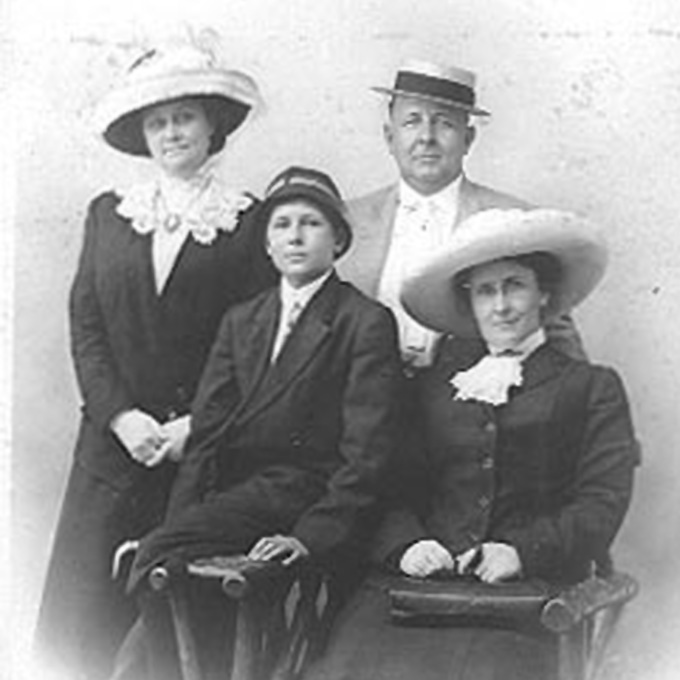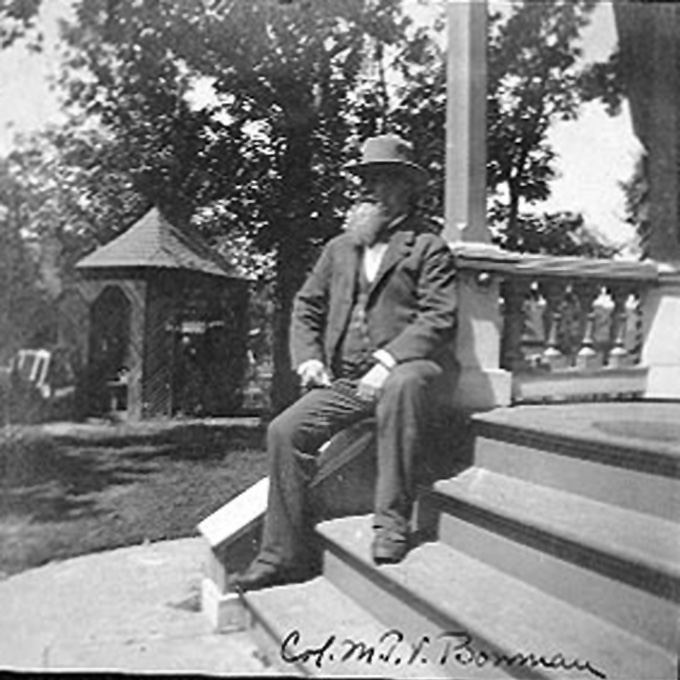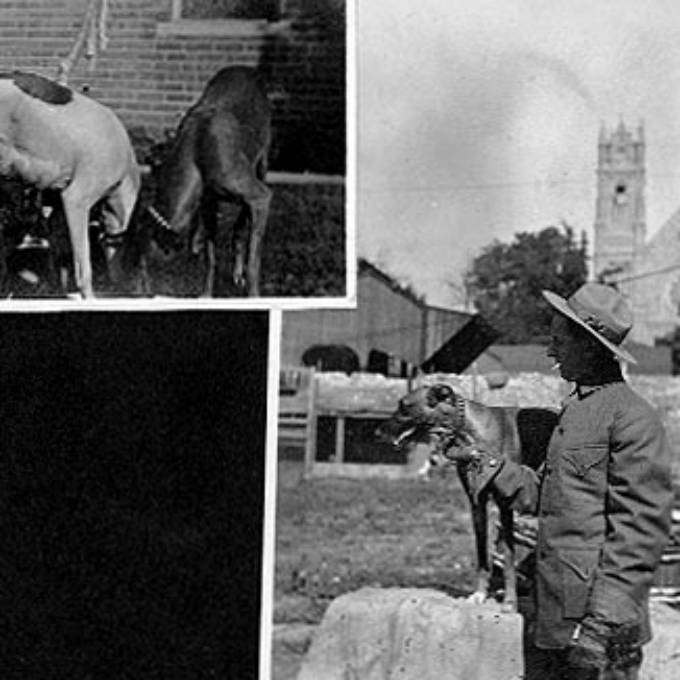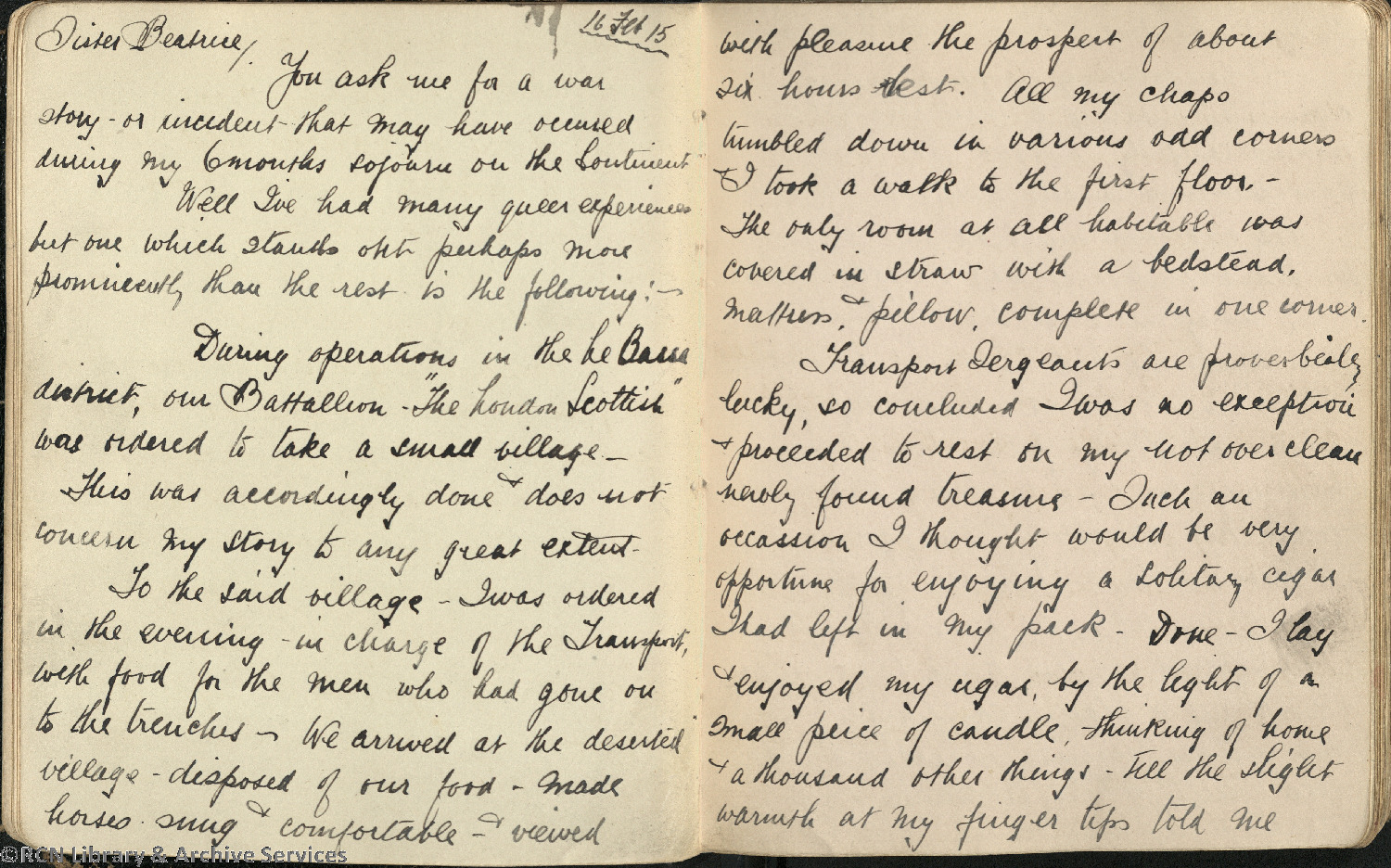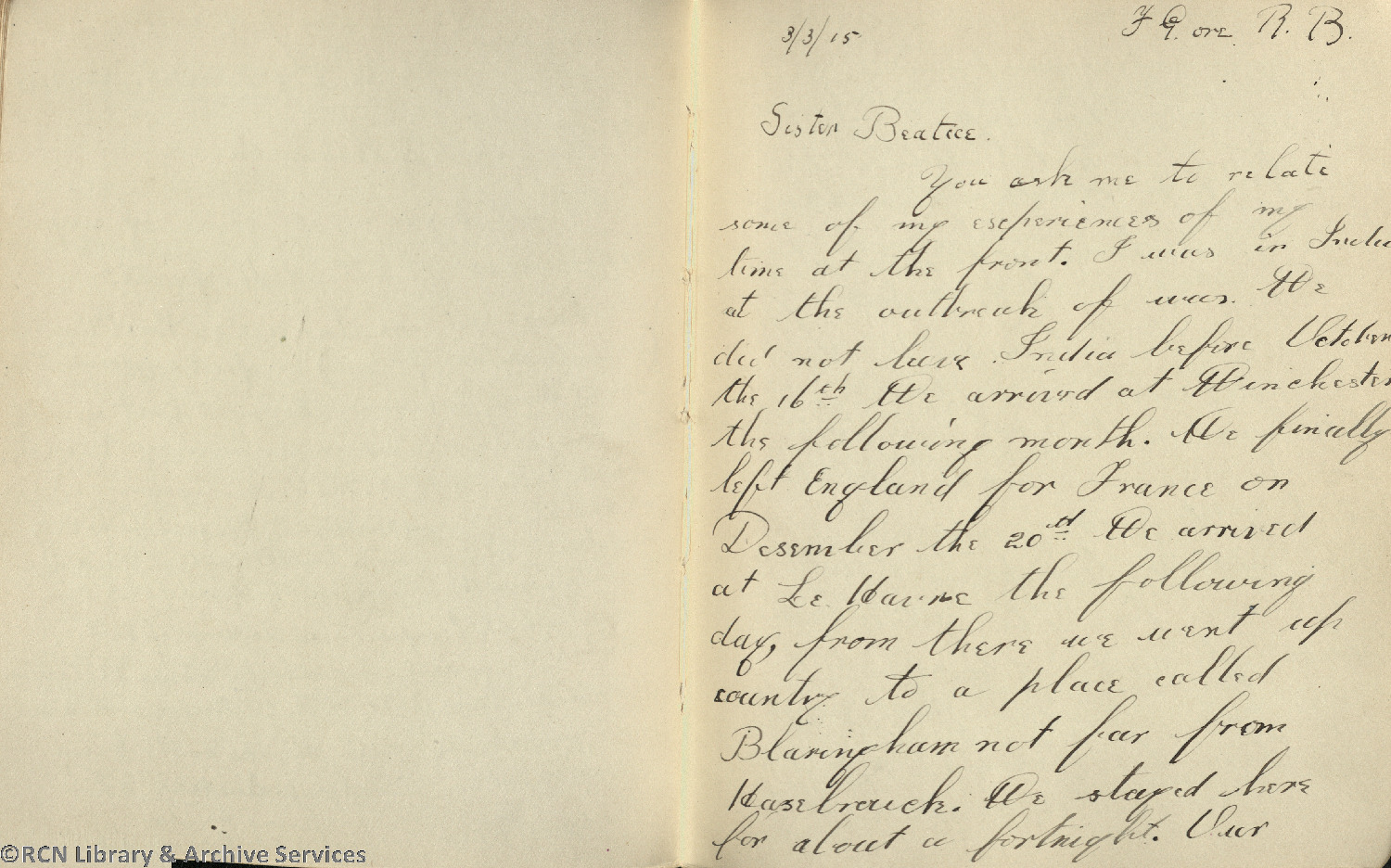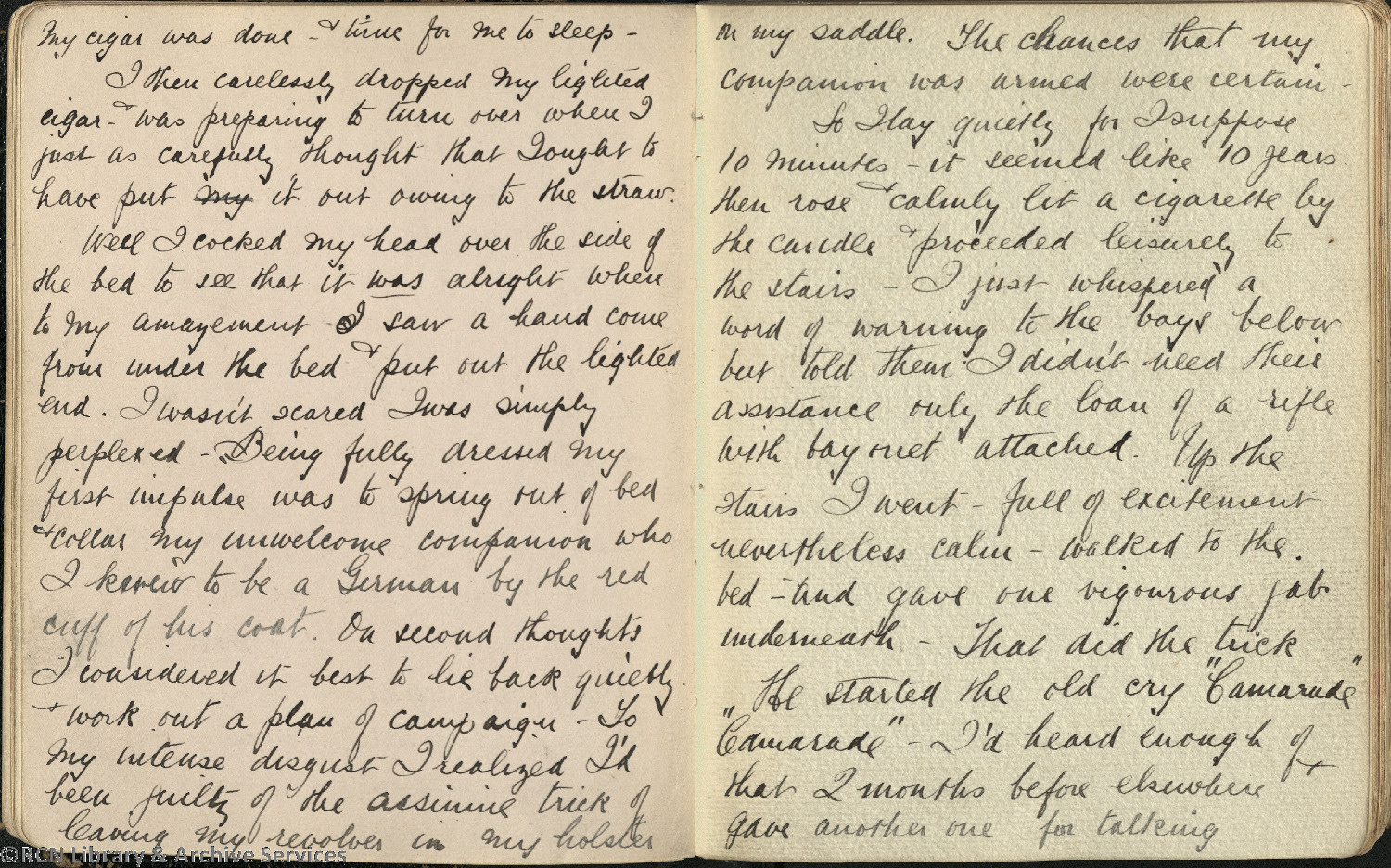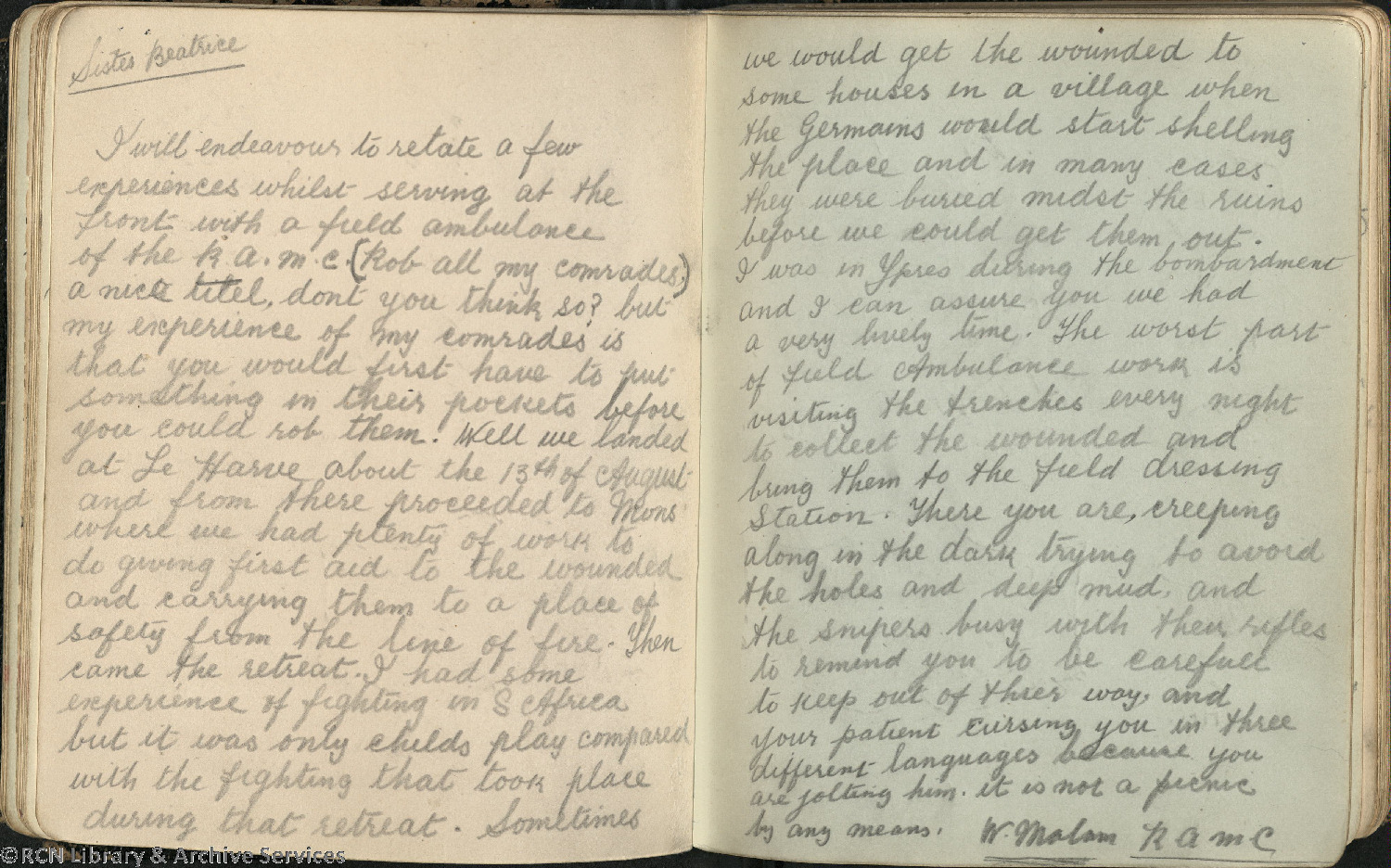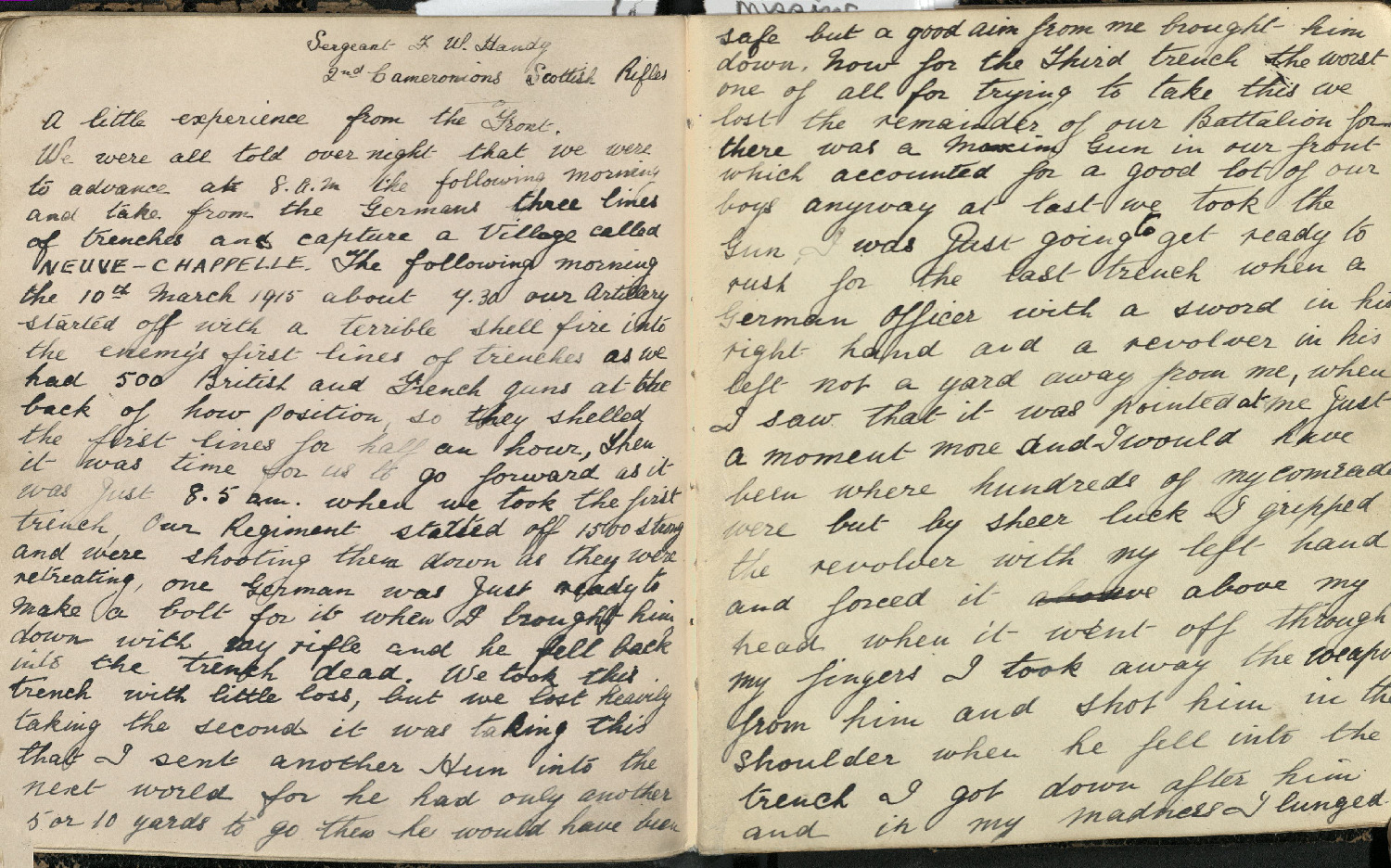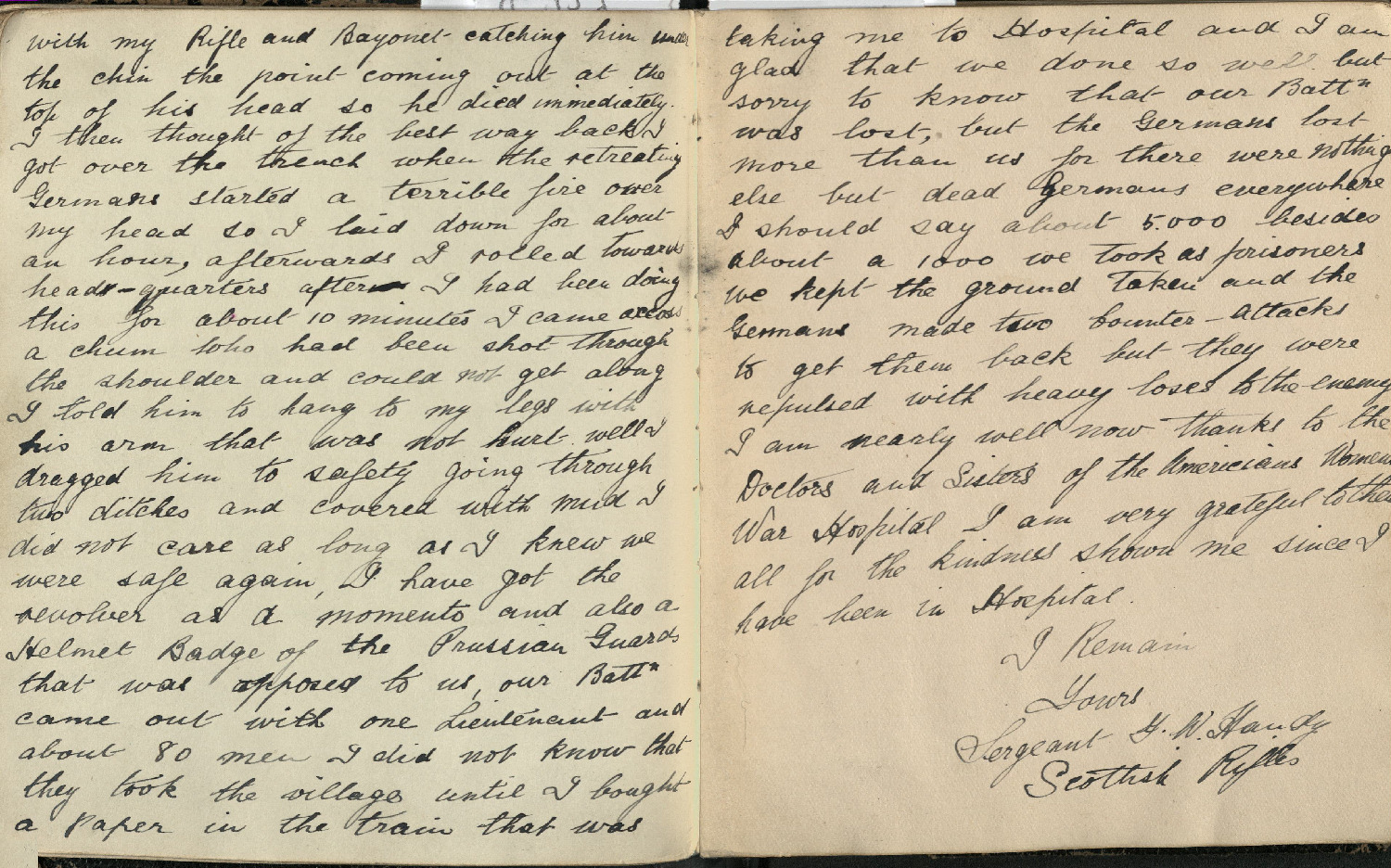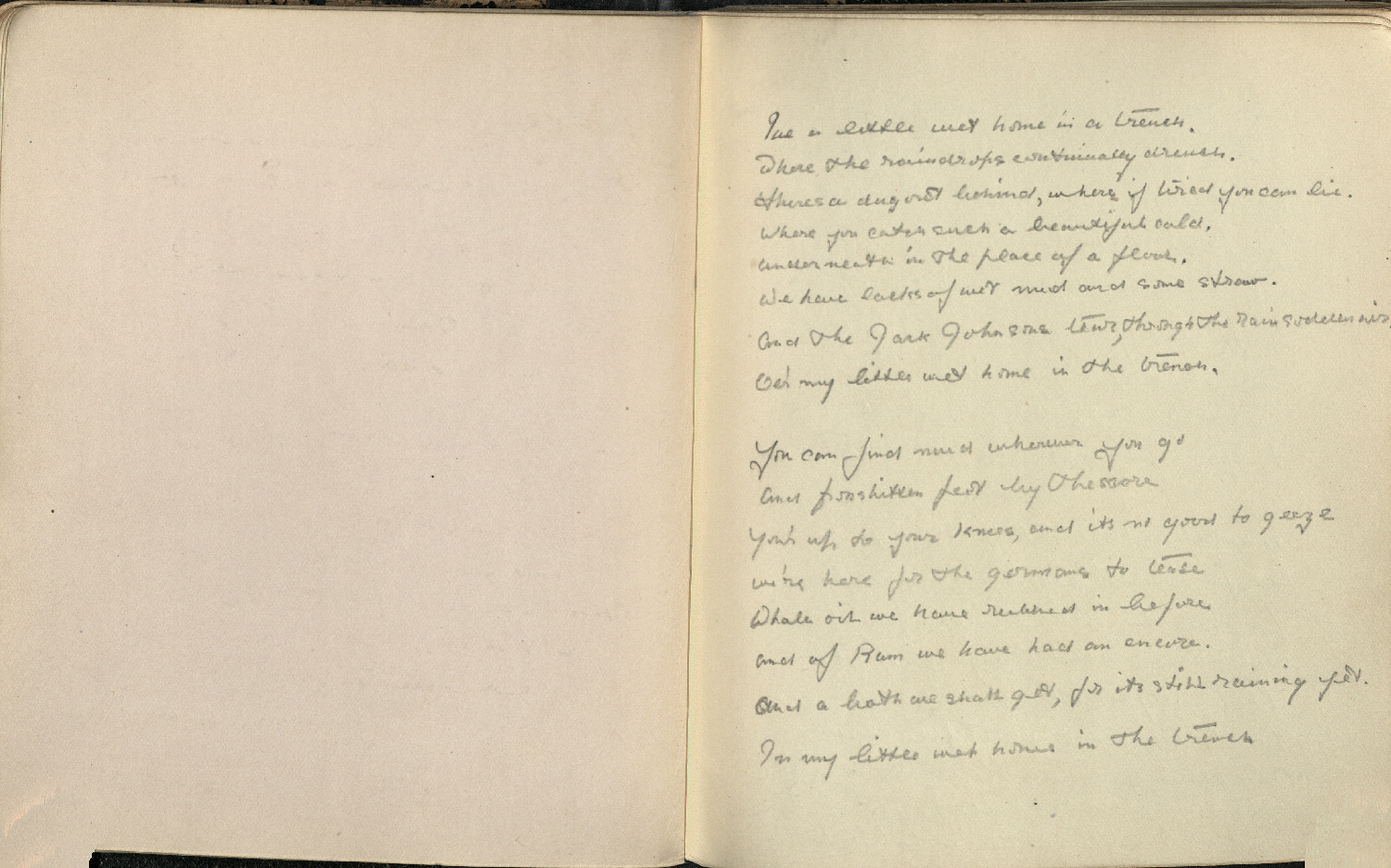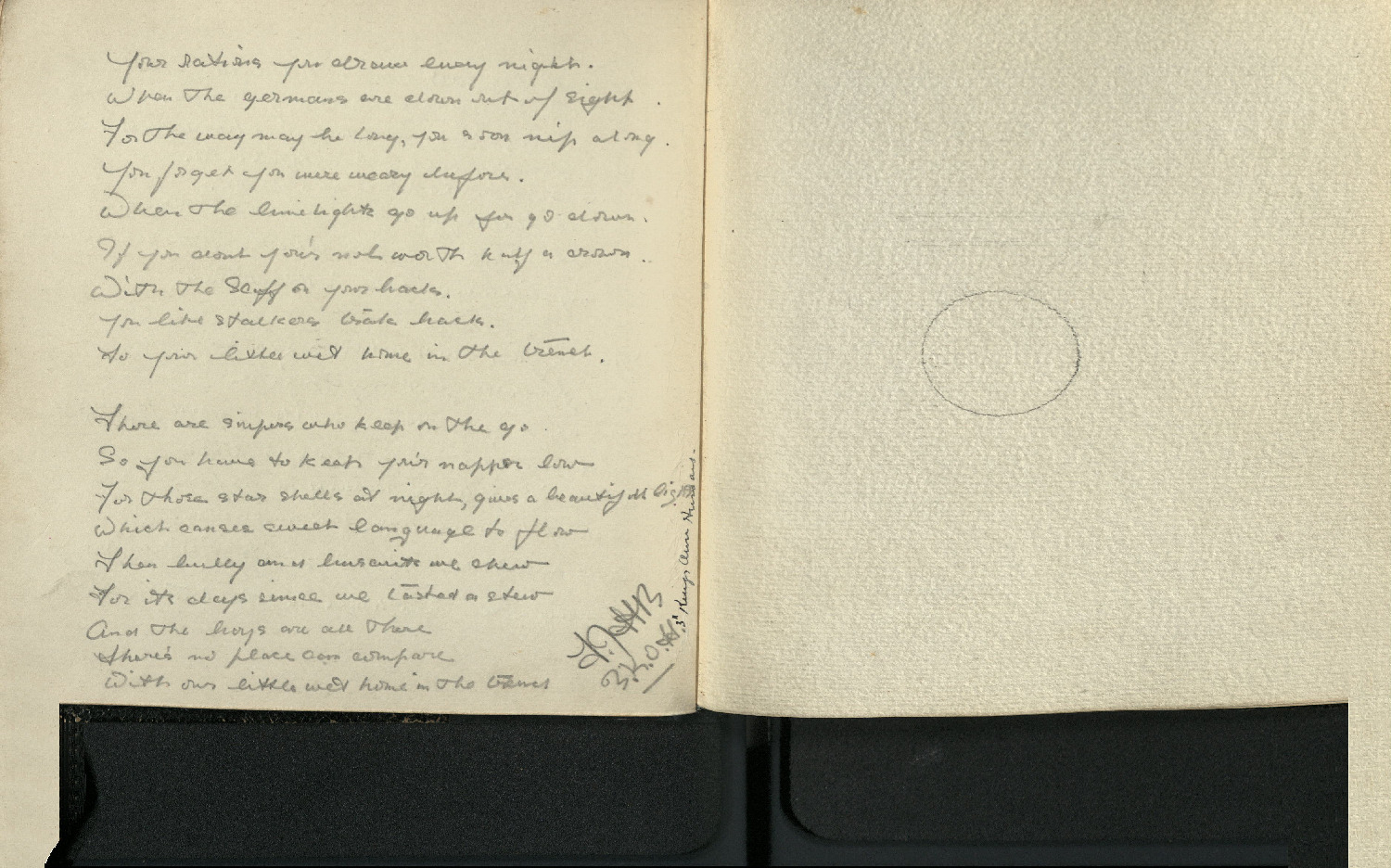Beatrice Bowman
"Dear Sister Beatrice..."
Introduction
Why did an American nurse decide to travel to the other side of the world to care for First World War wounded soldiers?
Josephine Beatrice Bowman was an exceptional woman whose fascinating career eventually led to one of the highest positions in nursing in the American Navy. She was born on 19 December 1881 in Iowa, USA to Colonel Martin Thomas Van Buren Bowman and Josephine Nancy Webber. She was one of five children.
In 1904, aged 23, she completed her nurse training at the Medico-Chirurgical Hospital in Philadelphia and enrolled with the American Red Cross Nursing Service. In 1908 she took part in the first Red Cross tornado disaster relief operation at Hattiesburg, Mississippi, for which she was decorated with a bronze Red Cross service bar.
In autumn of the same year Bowman joined the newly established U.S. Navy Nurse Corps as one of its first twenty members, called the 'Sacred Twenty'. They were the first female members to ever formally serve in the United States Navy representing the Nurse Corps. The women were required to be unmarried citizens of the United States, between the ages of 22 and 44. The Sacred Twenty were assigned to the U.S. Naval Hospital in Washington, D.C. for initial training. The Navy did not provide room or board for them, and so the nurses rented their own accommodation and provided their own meals. By 1911 Bowman had been promoted to Chief Nurse. The next year she was working in a Naval Hospital in Philadelphia.
The beautiful American Red Cross ship came into Falmouth Harbour on Thursday last week…
Bowman, The British Journal of Nursing, 3 October 1914
War broke out in Europe in the summer of 1914. By October 1914 Bowman had made the decision to temporarily leave the Navy to become a Red Cross nurse. America would not enter the war until April 1917, but upon the outbreak of war sent a single American Red Cross ship to provide medical relief for both sides. Bowman was a part of this effort, she would spend the next few months caring for war casualties in Great Britain, before the American Red Cross funding collapsed and she returned home.
Background image: The Sacred Twenty. Courtesy of Naval History & Heritage Command, S-581 Josephine Beatrice Bowman Collection.Munsey Ward
'At ten o'clock on the morning of October 3, we started for Gosport. Even the roads and foliage seemed old-world and quaint. Lady Hotham says that Americans are not considered foreigners here and indeed they do not treat us so. One would think we were some near relative turning up after years of separation.'
Bowman briefly served as the supervising nurse of Unit D, at Royal Naval Hospital Haslar, in Gosport. Only a few miles away from Portsmouth, Gosport would have been full of casualties who had been shipped straight from the front. After six weeks of ‘absorbingly interesting work’ at the Naval Hospital, the order came for Unit D to proceed to Paignton in Devonshire. An American millionaire, Paris Singer (of the sewing machine fortune), had loaned Oldway, his palatial estate, for use as the American Women’s War Hospital. Lady Randolph Churchill and an organisation of US women living in England, the American Women’s War Relief Fund, directed the project at Paignton. Whilst there, Bowman wrote of the spacious accommodation and a splendidly equipped hospital. She writes about how impressed she and her colleagues were with the pluck, patience, courage and cheerfulness of the British soldiers:
We realized what caliber they were made of when we heard the terrible conditions they faced to fight for their country
In the wards Bowman notes the particularly bad cases, and the cause of her patient’s injuries;
'One Scotch lad came in before Christmas with fifty wounds in his back, head and shoulders, bad wounds made by the explosion of a hand grenade. Another lad came to us with a badly fractured femur. He had lain on the battlefield from Tuesday until Friday with nothing to eat or drink, his kit being just out of reach. He did not know how long he had been unconscious, but upon coming to and thinking the British were around, raised himself and called – only to be instantly layed out again by a German bullet thru his shoulder.'
Bowman appears to have asked her patients what happened to them, and listened to the whole story. Her scrapbook is filled with these accounts, she was clearly very interested in how her patients were injured, and their time at the front.
Image: Nurses work outside the American Women’s War Hospital. Courtesy of the American Women’s War Hospital Website created and maintained by the Friends of Oldway group.
Tales from the Front
Bowman’s patients write a range of stories in her book. They were all in similar locations, supporting the trench warfare in France and Belgium, but their experiences wildly varied. Some stories are typified by their humour, an amazing feat considering the hardship they are describing. Stafford Ward describes the constant German barrage as different meals: 'The Devils gave us a great reception. We had Bombs for breakfast, bombs for dinner, an attack of every kind for tea, Star-shells for supper, and plenty of time during the night to digest the whole fare.' He also seems to have cast the Germans as ‘devils’, and later again refers to them as ‘demons’. Perhaps this humour and dehumanisation of the enemy helped him cope with the front line. In his letter to Bowman he mentions he is heading back to the front line.
Mud mud & still more mud
Sergeant F. W. Hardy of the Scottish Rifles has a similarly blasé nature in describing his time on the front line. He casually talks of the three German soldiers he killed, and of the tokens he keeps from the incident ‘I have got the revolver as a memento and also a Helmet Badge of the Prussian Guard that was opposed to us’. It is unclear why he kept these items, perhaps as a trophy. He also briefly talks about his daring rescue of an allied soldier in no-mans-land ‘a chum who had been shot through the shoulder and could not get along so I told him to hang to my legs with his arm that was not hurt well I dragged him to safety going through two ditches and covered with mud I did not care as long as I knew we were safe again’.
There’s no place can compare With our little wet home in the trench
Another patient sarcastically describes digging the trenches as ‘a splendid pastime for the soldiers, who very much adore it especially in wet weather.’ However, his story quickly veers from humour to horror as he describes his next few weeks on the front line;
these trenches in places was well over your knees in mud and water […] The place was full of dead soldiers
Bowman was also nursing W. Molam, a member of the Royal Army Medical Corps. He recounts the difficulties he encountered in his role. ‘I was in Ypres during the bombardment and I can assure you we had a very lively time. The worst part of Field Ambulance work is visiting the trenches every night to collect the wounded and bring them to the Field Dressing Station. There you are, creeping along in the dark trying to avoid the holes and deep mud, and the snipers busy with their rifles to remind you to be careful to keep out of their way, and your patient cursing you in three different languages because you are jolting him. It is not a picnic by any means.’ Like his fellow patients writing in Bowman’s book, Molam writes in an entertaining manner and seems concerned with making light of his trials at the front.
Background image: patients pose outside the American Women’s War Hospital. Courtesy of the American Women’s War Hospital Website created and maintained by the Friends of Oldway group.
I have not got a big lot to say as I have not been out as long at front as long as some of the boys but still I was out there plenty long enough I can tell you...
The scrapbook shows that not all the soldiers were able to tell their wartime stories with such joviality. Corporal L. Watson talks of his naivety before he saw any combat ‘my first experience of war […] previous to it I did not think it was so bad.’ He was quick to change his opinion after his first attack on a trench;
‘On reaching the trench we jumped in & soon got to our terrible work with the bayonet & in a few minutes the trench was running with blood […] The sight was awful & the cries of those in agony was terrible.’
It is a haunting description of war. There are many similarly harrowing tales throughout the scrapbook. Perhaps Bowman was attempting to let these soldiers have a new means of expressing and recounting their experiences. For many of the soldiers it may have been a cathartic exercise. Bowman may have asked them to write down their experiences if they were unable to articulate what happened to them. At first Sergeant Sanderson seems to struggle to find the words to describe his experiences, before he writes a relentless account across three pages.
‘I cannot describe the next half hour. Shell after shell came crashing round us. Stones, bricks and mud flew in all directions & I thought my time had come. The din was awful. A cloud of thick black smoke enveloped us […] he lay near where the shell burst, and poor fellow was badly battered but alive. A Private lay near him with half his leg blown away. We did our best for both of them, and when the shelling stopped had them taken to the Dressing Station. How we lived through that terrible time God only knows & for weeks after the very sound of a gun firing made me tremble.’
I experienced tortures of Hell
Background image: Munsey Ward, where Bowman worked. Courtesy of the American Women’s War Hospital Website created and maintained by the Friends of Oldway group.
Locations of battlefield injury
Hazebrouck. One soldier's time here was occupied by trench digging. Another had an operation in the hospital here.
La Basse. H. W. Fairlie had a grisly encounter with a German soldier here.
The Battle of the Marne was fought from 6-10 September 1914. Three soldiers mention fighting here.
Mons. Many soldiers mention being present for the Battle of Mons, and even more mention the retreat. One described it as a "very touching and pitiful sight".
Neuve Chapelle. Private J. H. Bugler called fighting here a living hell.
The River Aisne. Stafford Ward writes "the enemy then entrenched themselves in at the Aisne" from 12-15 September 1914, where "thousands of shells were poured into us and over us".
Ypres. Corporal H. Day was wounded by a sniper here. Stafford Ward called the action here "by far the worst of my experience".
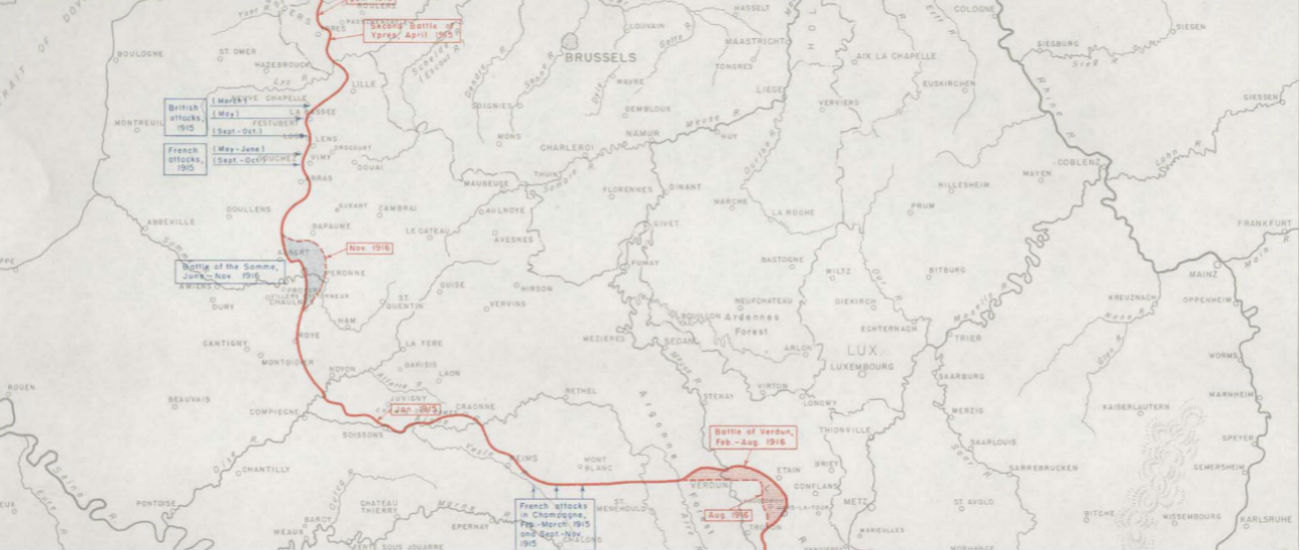
Plucky Germans
Heartbreakingly there are accounts acknowledging the courage of the German troops. Corporal Watson referred to them as ‘plucky’ and Private Gordon Legg writes ‘on the slope up to the German trenches on the night are still lying the bodies of many a good Scot side by side with his brave enemy.’ He is able to recognise the devastation the war was causing to both sides. One of the patients recounts his time in the famous 1914 Christmas truce. This was a poignant moment from early on in the war. Many of the trenches ceased fighting for the day. Soldiers were able to meet in no-mans-land to exchange seasonal greetings and even gifts. It seems to have affected E. J. Beer, the author of this account, who certainly thought it was an event to remember.
I left the Base and went to join the 2nd Devons and went into the trenches on Christmas Eve. On Christmas day we had a truce with the Enemy and the day went off allright. Those Germans who were with us appeared to be a decent lot of chaps.
After 1914, both sides top command tried to prevent any more similar truces occurring, perhaps due to the way the encounters affected soldiers such as Beer.
Thanks
The scrapbook is not solely filled with the soldier’s stories. One of them leaves a photograph (presumably of himself), another does an illustration of his company’s insignia. Another expresses his experiences in a poem entitled ‘Frozen Feet’.
Just a pair of frozen feet
Standing in trenches wet & cold
Bramhall takes the time to thank his ‘friends’ from the America who ‘Who work all day & work all night, And do their best to get chaps right’. He is not the only one to express gratitude to the staff of the American Women’s War Hospital, most of the soldiers close their entries with similar compliments. Sergeant Hardy writes ‘I am mostly well now thanks to the Doctors and Sisters of the American Women’s War Hospital I am very grateful to them all’.
However, most of the patients concentrate on the attentions of Bowman herself, and the scrapbook is filled with tributes to her. Sergeant Morris ends his entry with sincere thanks to ‘Sister Beatrice for the Kindness and Sympathy she has bestowed upon me during my stay’. Corporal Day expresses mirroring sentiments, thank Bowman for her ‘Kindness to me’. Clearly Bowman was popular with her patients, they all appear to have willingly written in her scrapbook, eager to please Bowman and answer her request for their stories. She maintained correspondence with at least one of her patients, Stafford Ward, as his letter was kept inside her scrapbook. Clearly he did not want to forget Bowman, and the letter appears to be one of quite a few. He writes;
So pleased to hear the sweets reached you all in a good condition
In October 1915 the American Red Cross units were called home due to lack of funds. Bowman would have undoubtedly been missed by all the men on her ward who took the time to write in her scrapbook. She had spent nearly a year nursing in Britain, and had managed to keep her scrapbook with her for most of that time recording a fantastic range of events and human experience from the era. Importantly, it also shows just how crucial the work Bowman, and women like her, were doing. The pages of grateful patients are a true testament to Bowman’s exceptional nursing ability.
Third image: Bowman [on the left] and colleague. Courtesy of Naval History & Heritage Command, S-581 Josephine Beatrice Bowman Collection.
After Britain
Bowman returned to the Navy in May 1915. In early 1916 she arrived in Guam, a territory of the USA in the Western Pacific Ocean, to conduct a two-year course in modern midwifery and practical nursing at the Navy Nurse's training school for the local Chamorro women, which later allowed trained nurses to provide more complete healthcare to the villages to which they were assigned.
In April 1917, the USA entered the First World War and Bowman became Chief Nurse at the Naval Hospital, Great Lakes, Illinois, guiding nursing staff to meet the needs of war and the 1918-19 influenza epidemic.
In 1919, Chief Nurse Bowman led the first contingent of Navy nurses assigned to the hospital ship USS Relief (AH-1), the first Navy women to serve at sea.
She became the third Superintendent of the Navy Nurse Corps in December 1922 and held that position for over twelve years, until her retirement at the beginning of 1935. As Superintendent, she introduced mandatory inspections of all naval hospitals in order to create a more consistent standard of nursing and to gain firsthand experience of what challenges different hospitals and nurses faced. Bowman also encouraged Navy nurses to continue their education and keep up-to-date with developments in medicine by taking postgraduate courses.
Following her departure from active duty, Bowman made her home in Pennsylvania and stayed active in national and local nursing affairs. When Navy nurses were eventually included in the Navy's ranking system, she received the retirement rank of Lieutenant Commander.
Bowman died in Pennsylvania on 3rd January 1971 and is buried at Arlington National Cemetery.
Background image: Bowman standing in the centre aboard USS Relief, 1921. Courtesy of Naval History & Heritage Command, S-581 Josephine Beatrice Bowman Collection.
Images
Banner image taken from: Naval History and Heritage Command, S-581 J. Beatrice Bowman Collection https://www.history.navy.mil/our-collections/photography.html
All photographs of Bowman and family taken from: Naval History and Heritage Command, S-581 J. Beatrice Bowman Collection https://www.history.navy.mil/our-collections/photography.html
All photographs of the American Women’s War Hospital [Oldway Mansion] grounds and staff are taken from: The American Women's War Hospital Website created and maintained by the Friends of Oldway group. (website currently suspended 10/12/2025).
References
Gavin L (1997) American Women in World War 1: They Also Served. University Press of Colorado. USA. Chapter 8: Red Cross Volunteers, p.182 (Section 146 History of American Red Cross Nursing)
The British Journal of Nursing, Volume 53, 3rd October 1914, p. 268 [Bowman’s name misspelt as Burman]
American Journal of Nursing, Volume 15, no. 12 1915, p.1112 Available at: https://archive.org/details/jstor-3405291
Dexter, Mary (1918) In the Soldier's Service: War Experiences of Mary Dexter: England, Belgium, France, 1914-1918. Available at: https://archive.org/details/01110240R.nlm.nih.gov [Accessed 27 Feb. 2018]
BBC World War One at Home – Paignton, Devon: The Singer Palace Becomes a Hospital. Available at: http://www.bbc.co.uk/programmes/p01sf5n7 [Accessed 27 Feb. 2018]
